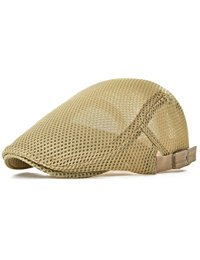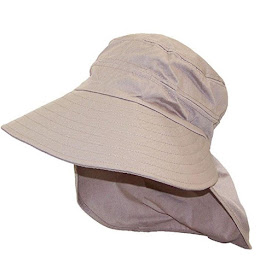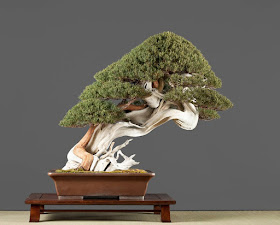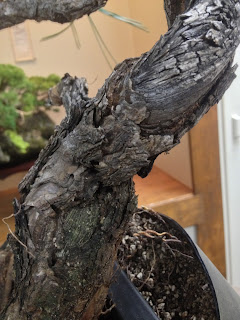What do you do when you live in a country with limited space but want to exercise your green fingers or express your love, and even your spiritual reverence, for nature? Well, you can always do things in miniature - ikebana and bonsai are your two main options. Though the word 'ikebana
and bonsai are your two main options. Though the word 'ikebana ' literally means 'living flowers', it is actually the visual presentation of cut stems, flowers, and other features to represent an aspect of nature in miniature. Bonsai, on the other hand, means 'pot plant' and the art form involves raising living trees, often over a period of several years. While they are small, bonsai are not actually different from the trees we see around us, they are not miniature species. Rather they are small branches of a tree, carefully chosen, pruned, and cultivated so that they look like smaller versions of their own species. They are also displayed in a way that shows off their best features, usually in a simple, shallow pot. Bonsai is about the combination of the plant and the pot. There are many different styles of bonsai such as: broom style - a tapered trunk topped by a symmetrical area ofSaikei
' literally means 'living flowers', it is actually the visual presentation of cut stems, flowers, and other features to represent an aspect of nature in miniature. Bonsai, on the other hand, means 'pot plant' and the art form involves raising living trees, often over a period of several years. While they are small, bonsai are not actually different from the trees we see around us, they are not miniature species. Rather they are small branches of a tree, carefully chosen, pruned, and cultivated so that they look like smaller versions of their own species. They are also displayed in a way that shows off their best features, usually in a simple, shallow pot. Bonsai is about the combination of the plant and the pot. There are many different styles of bonsai such as: broom style - a tapered trunk topped by a symmetrical area ofSaikei is similar to and often confused with bonsai, but is actually closer to ikebana
is similar to and often confused with bonsai, but is actually closer to ikebana . Different species of small trees as well as other plants, rocks and sand are used to create miniature landscapes.
. Different species of small trees as well as other plants, rocks and sand are used to create miniature landscapes.
 |
| Classical Japanese Bonsai Paintings |
Foliage; cascading style - the pot is kept on a platform and the branches 'cascade' down below it; windswept style - resembles a tree that has grown up in an area exposed to strong winds.
Gardening in many forms has been enjoying something of a boom in Japan in recent years and those with limited space have been rediscovering the charms and challenges of this part of their native culture. As I said, bonsai are real trees in miniature and are not usually suitable as houseplants (some species have been developed for indoors). Usually, they are hardy and can handle most weather. In fact, their growth may be adversely affected by artificial (ie. indoor) light and heat conditions, depending on your climate and the origin of the tree species.
(some species have been developed for indoors). Usually, they are hardy and can handle most weather. In fact, their growth may be adversely affected by artificial (ie. indoor) light and heat conditions, depending on your climate and the origin of the tree species.
Even a small city apartment balcony can be big enough to build up a collection, something of an oasis for many urban dwellers. The smallest of bonsai, called mame (bean) can be just a couple of inches tall and a collection may also have trees a couple of feet high. The most popular are about 6 inches to a foot.
For the more serious gardener, it is possible to grow bonsai from seeds, cuttings, a branch while it is still on a living tree, or even prune and adapt a tree from a garden center. But these are long and laborious processes, taking several years before you have any kind of 'finished product'. Indeed some of the most prized bonsai have been around a lot longer than their owners. Some enthusiasts go to great expense to buy bonsai from dealers but if you just want to dabble or test the waters, it is possible to start off with a good guidebook and a domestic plant (cheaper than imports) from a hobby or gardening shop for just a few thousand yen. I watched a program on TV last night where bonsai amateurs had to guess the values of various high-quality specimens. The most expensive looked similar to the one in the photo above and was valued at over 5.5 million yen (almost 50,000 dollars!). Special qualities that made that particular specimen so valuable included the unusual (for the species) thickness of its trunk and branches and its old age.
In a nutshell - how the art of Bonsai started
The history of bonsai (pronounced bon-sigh) is cloaked in the mist of the past but it is now widely accepted that it was the Chinese who first created the miniature landscapes and trees that we now know as bonsai.
(pronounced bon-sigh) is cloaked in the mist of the past but it is now widely accepted that it was the Chinese who first created the miniature landscapes and trees that we now know as bonsai.
In Japanese, bonsai can be literally translated as "tray planting", but since originating in Asia so many centuries ago - it has developed into a whole new form. Called penjing by the Chinese, bonsai was believed to have had its start in the Han Dynasty
by the Chinese, bonsai was believed to have had its start in the Han Dynasty . In this essay, I will discuss some of the legends and facts surrounding the beginning of bonsai. One of the earliest Chinese legends contends that it was in the Han Dynasty (206 B.C. - 220 A.D.) that an emperor created a landscape in his courtyard complete with hills, valleys, rivers, lakes and trees that represented his entire empire. He created the landscape so that he could gaze upon his entire empire from his palace window. This landscape form of art was also his alone to possess. It was said that anyone else found in possession of even a miniature landscape was seen as a threat to his empire and put to death.
. In this essay, I will discuss some of the legends and facts surrounding the beginning of bonsai. One of the earliest Chinese legends contends that it was in the Han Dynasty (206 B.C. - 220 A.D.) that an emperor created a landscape in his courtyard complete with hills, valleys, rivers, lakes and trees that represented his entire empire. He created the landscape so that he could gaze upon his entire empire from his palace window. This landscape form of art was also his alone to possess. It was said that anyone else found in possession of even a miniature landscape was seen as a threat to his empire and put to death.
Another Chinese legend relating to the beginnings of bonsai points to the fourth century A.D. Chinese poet and civil servant named Guen-ming. It's believed that after his retirement he began growing chrysanthemums in pots. Some historians believe this was a step towards the beginning of bonsai in the Tang dynasty some 200 years later. The earliest documented proof of bonsai was discovered in 1972 in the tomb of Prince Zhang Huai, of the Tang Dynasty (618 - 907 A.D.) who died in 706 A.D. Two wall paintings discovered in the tomb show servants carrying plants resembling bonsai. In one of the paintings a servant is seen carrying a miniature landscape and in the other painting, a servant is shown carrying a pot containing a tree.
Bonsai comes to Japan
Even though it's the Japanese who get most of the credit for bonsai, it wasn't until the Heian period (794 - 1191A.D.) that Buddhist monks brought bonsai to the island. For many years following the arrival of bonsai, the art was practiced by only the wealthy and thus came to be known as a nobleman privilege. The fact that the art of bonsai was limited to the noble class almost caused the art to die out in Japan. It was with the Chinese invasion of Japan in the fourteenth century
(794 - 1191A.D.) that Buddhist monks brought bonsai to the island. For many years following the arrival of bonsai, the art was practiced by only the wealthy and thus came to be known as a nobleman privilege. The fact that the art of bonsai was limited to the noble class almost caused the art to die out in Japan. It was with the Chinese invasion of Japan in the fourteenth century that the art of bonsai started to be practiced by people of all classes. Once the art was practiced by all classes, bonsai began to grow in popularity in Japan. The Chinese influence on the early bonsai masters is apparent since the Japanese still use the same characters to represent bonsai as the Chinese. After the establishment of bonsai in Japan, the Japanese went to great lengths to refine the art and a lot of credit must go to these early bonsai masters. The refinements that they developed have made bonsai what it is today.
that the art of bonsai started to be practiced by people of all classes. Once the art was practiced by all classes, bonsai began to grow in popularity in Japan. The Chinese influence on the early bonsai masters is apparent since the Japanese still use the same characters to represent bonsai as the Chinese. After the establishment of bonsai in Japan, the Japanese went to great lengths to refine the art and a lot of credit must go to these early bonsai masters. The refinements that they developed have made bonsai what it is today.
 The earliest bonsai to come to the West came mostly from Japan and China. The showing of bonsai at the Third Universal Exhibition in Paris in 1878 and later exhibitions in 1889 and 1900 increased Western interest in bonsai and opened the door for the first major bonsai exhibit held in London in 1909. In these early years, many Westerners felt that the trees looked tortured and many openly voiced their displeasure with the way the trees were being treated by bonsai masters. It wasn't until 1935 that opinions changed and bonsai was finally classified as an art in the West. With the end of World War II, bonsai started to gain in popularity in the West. It was the soldiers returning from Japan with bonsai in towns that sparked Western interest in the art, even though most of the trees brought home by these soldiers died a short time after their arrival. They survived long enough to create a desire in Westerners to learn more about the proper care of their bonsai.
The earliest bonsai to come to the West came mostly from Japan and China. The showing of bonsai at the Third Universal Exhibition in Paris in 1878 and later exhibitions in 1889 and 1900 increased Western interest in bonsai and opened the door for the first major bonsai exhibit held in London in 1909. In these early years, many Westerners felt that the trees looked tortured and many openly voiced their displeasure with the way the trees were being treated by bonsai masters. It wasn't until 1935 that opinions changed and bonsai was finally classified as an art in the West. With the end of World War II, bonsai started to gain in popularity in the West. It was the soldiers returning from Japan with bonsai in towns that sparked Western interest in the art, even though most of the trees brought home by these soldiers died a short time after their arrival. They survived long enough to create a desire in Westerners to learn more about the proper care of their bonsai.
The large Japanese-American population was invaluable to Americans in this respect. Their knowledge of the art of bonsai was of great interest ot many Americans learning the art. Today, bonsai are sold in department stores, garden centers, nurseries, and many other places. However, most of these are young cuttings or starts and not the true bonsai produced by bonsai masters. Most trees purchased today are known as pre-bonsai
population was invaluable to Americans in this respect. Their knowledge of the art of bonsai was of great interest ot many Americans learning the art. Today, bonsai are sold in department stores, garden centers, nurseries, and many other places. However, most of these are young cuttings or starts and not the true bonsai produced by bonsai masters. Most trees purchased today are known as pre-bonsai and are for the most part only used as a starting point. To create a true bonsai work of art you need to learn as much as possible about the art and the trees you use. Information is your key to success and it is important to read as much as possible. It is also a good idea to join a local bonsai club so you are able to discuss the subject with experienced bonsai enthusiasts. As your knowledge and confidence grow, creating your own bonsai works of art will become easier and your enjoyment of bonsai will grow.
and are for the most part only used as a starting point. To create a true bonsai work of art you need to learn as much as possible about the art and the trees you use. Information is your key to success and it is important to read as much as possible. It is also a good idea to join a local bonsai club so you are able to discuss the subject with experienced bonsai enthusiasts. As your knowledge and confidence grow, creating your own bonsai works of art will become easier and your enjoyment of bonsai will grow.
Interesting Books on Bonsai can be found here:
The Complete Book of Bonsai --> I've been into bonsai for 25 years and this is the basic Bible for beginner and intermediate bonsai enthusiasts. It has an excellent section on techniques, including pruning, wiring and whatnot, and it has a large species-specific tree guide. If you're into bonsai and want only one book, this is it.
Indoor Bonsai The Great Selection --> Creating beautiful, healthy bonsai is a wonderful skill that anyone can learn, with a little time, patience, and this all-inclusive manual. With color photos and drawings to illustrate the points, it introduces all the cultivation techniques; offers expert advice on location, soil types, watering, and pest control; and provides intricate instruction on training the bonsai--including pruning, wiring and stretching it.
The Secret Techniques of Bonsai --> In The Secret Techniques of Bonsai, the author of the groundbreaking Bonsai With American Trees teams up with his son to offer not only the basics for creating perfect bonsai, but also secret techniques they’ve developed over years of careful work and observation.
Bonsai Survival Manual --> Problem solving when your Bonsai gets sick. Expand your gardening repertoire as you create a captivating and exquisite miniature world. In this introductory guide, Colin Lewis covers everything you need to know to design, grow, and successfully maintain attractive bonsai.
Bonsai and the art of Penjing --> Bonsai & Penjing, Ambassadors of Beauty and Peace describe how Chinese penjing and North American bonsai were later added to the Museum, making its collection the most comprehensive in the world. Stories of individual trees and forest plantings are featured, as are the roles played by the skilled and talented creators of these living art forms people such as John Naka, Saburo Kato, Yuji Yoshimura, Harry Hirao, and Dr. Yee-Sun Wu.
Bonsai and the art of Penjing --> Bonsai & Penjing, Ambassadors of Beauty and Peace describe how Chinese penjing and North American bonsai were later added to the Museum, making its collection the most comprehensive in the world. Stories of individual trees and forest plantings are featured, as are the roles played by the skilled and talented creators of these living art forms people such as John Naka, Saburo Kato, Yuji Yoshimura, Harry Hirao, and Dr. Yee-Sun Wu.
Bonsai with Japanese Maples --> With their delicate foliage, seasonal color changes, and intricate pattern of branching, Japanese maples are among the most popular and suitable plants for bonsai design. In this long-awaited book, internationally renowned expert Peter Adams discusses both the specific horticultural needs of Japanese maples as bonsai subjects and illustrates proven techniques for creating and maintaining beautiful specimens.
The Modern Bonsai Practice --> The most current, useful information on growing Bonsai. Fresh, practical, definitive, comprehensive reference guide to the finest art of horticulture: growing miniature trees. Common sense bonsai answers separating myth from fact with depth and detail. Appropriate for both bonsai hobbyists and experienced practitioners.
More Bonsai articles can be found here:
Please click here for more information on --> Chinese Penjing Bonsai
Please click here for more information on --> The Art of Saikei Bonsai
Please click here for more information on --> Japanese Tanuki Bonsai
Please click here for more information on --> How to Water a Bonsai
Please click here for more information on --> Bonsai Healing Methods
 Japanese Av Star
Japanese Av Star




























